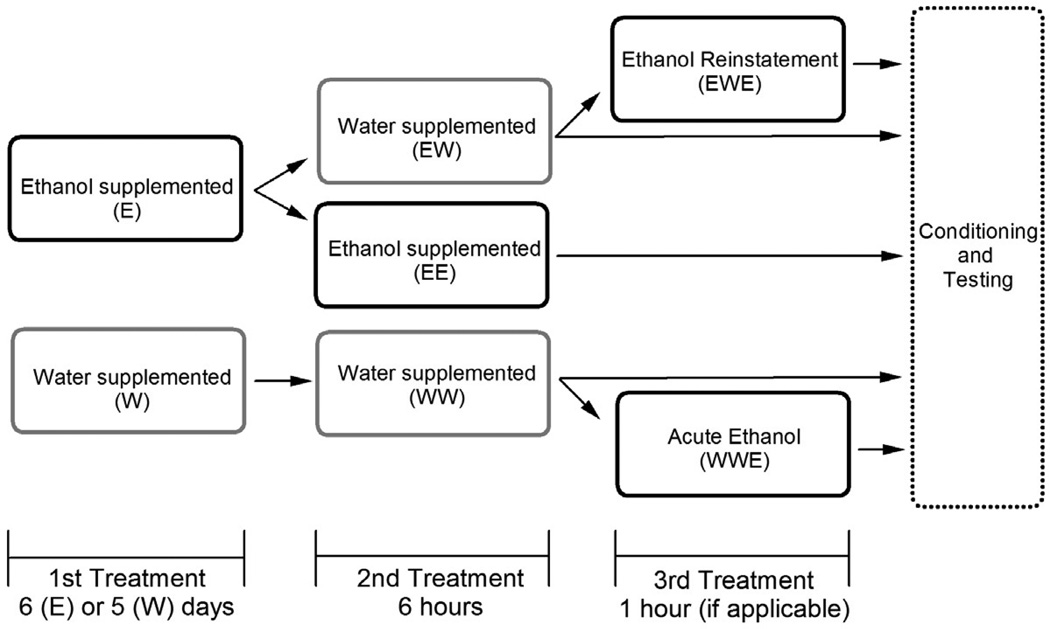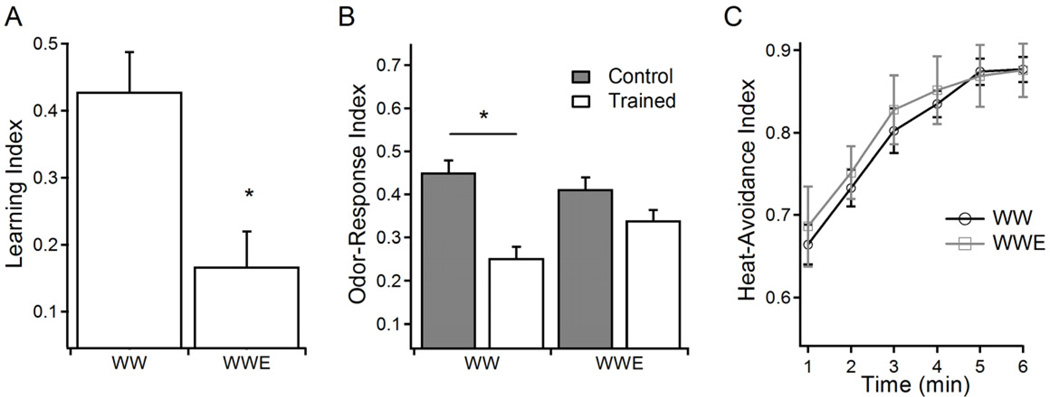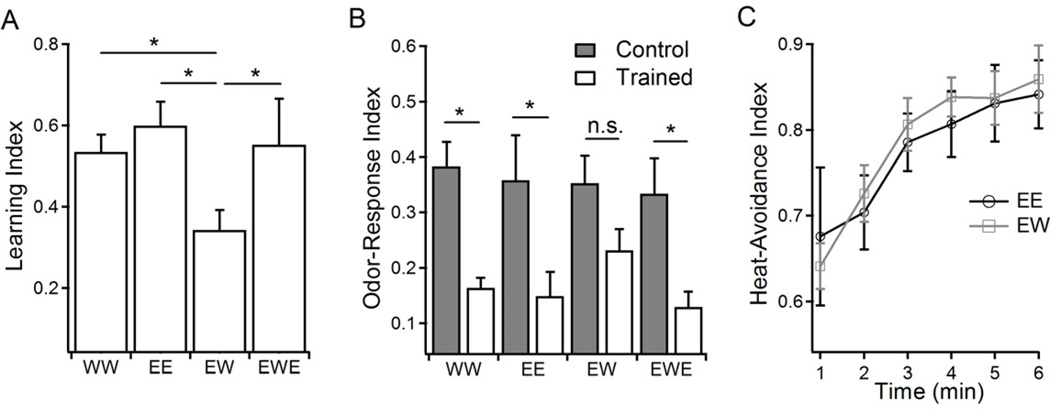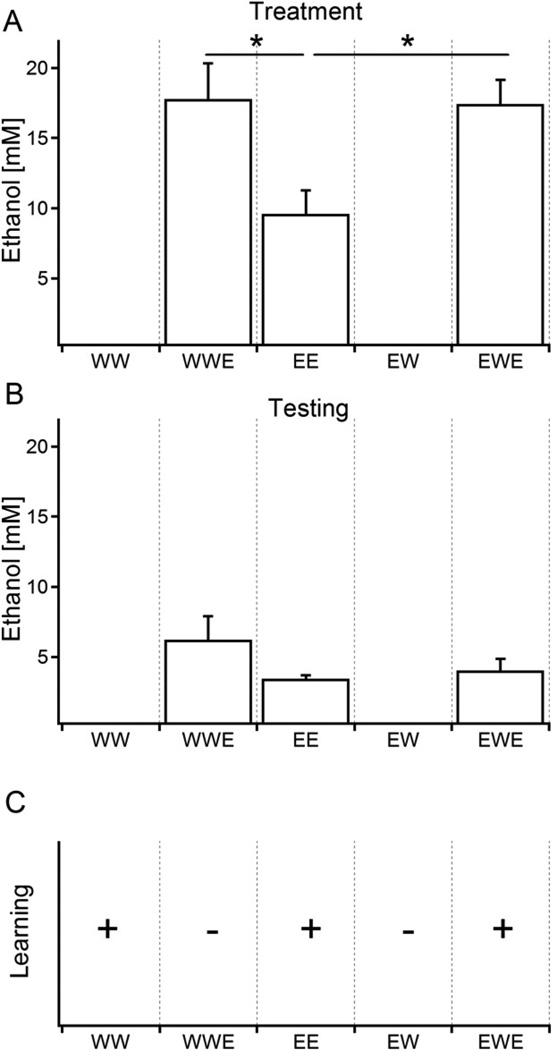Summary
Physiological alcohol dependence is a key adaptation to chronic ethanol consumption that underlies withdrawal symptoms, is thought to directly contribute to alcohol addiction behaviors, and is associated with cognitive problems such as deficits in learning and memory [1–3]. Based on the idea that an ethanol-adapted (dependent) animal will perform better in a learning assay than an animal experiencing ethanol withdrawal will, we have used a learning paradigm to detect physiological ethanol dependence in Drosophila. Moderate ethanol consumption initially degrades the capacity of larvae to learn, but they eventually adapt and are able to learn as well as ethanol-naive animals. However, withholding ethanol from ethanol-adapted larvae impairs learning. Ethanol reinstatement restores the capacity to learn, thus demonstrating cognitive dependence on ethanol. The larval nervous system also shows ethanol withdrawal hyperexcitability. Larvae reach ethanol concentrations equivalent to 0.05 to 0.08 BAC—levels that would be mildly intoxicating in humans. These ethanol-induced changes in learning are not the product of sensory deficits or state-dependent learning. This is the first demonstration of cognitive ethanol dependence in an invertebrate genetic model system.
Results and Discussion
To test for chronic ethanol adaptation and to determine whether abstinence precipitates a withdrawal syndrome, we used an olfactory heat-shock conditioning assay [4] in which larvae associate a heat pulse (US) with an otherwise attractive odor (CS). Associative learning reduces attraction to the odor. The paradigm in Figure 1 allows comparisons of the effects of acute ethanol, chronic ethanol, ethanol abstention, and ethanol reinstatement. An abbreviated nomenclature for each group is described in Figure 1 (WWE, EE, EW, EWE). In this paradigm, larvae are exposed to ethanol as a 5% supplement to their food. This "ethanol food" is at the high end of the range of ethanol concentrations encountered by larvae in the wild [5].
Figure 1. Experimental design.
Larvae were raised in ethanol (E)- or water-supplemented food (W, non-ethanol). To test for an ethanol-withdrawal effect on learning, two thirds of the E larvae were placed on water-supplemented food (EW; withdrawal group) for six hours. The remaining one third of the E larvae were placed on ethanol-supplemented food (EE) for six hours. To determine whether ethanol withdrawal compromised learning, learning was compared in the EW and EE groups. To determine if ethanol reinstatement could reverse withdrawal effects, half of the EW group was moved back to ethanol food for one hour (EWE), and the capacity to learn was measured. Larvae raised on non-ethanol food were also prepared (W; the water supplemented group) purified and placed back on food without ethanol (WW). After six hours WW was split in half. One half was assayed for the ability to learn. The other half was placed on ethanol food for one hour (WWE) and then assayed for the capacity to learn.
Acute Ethanol Impairs Learning
Larvae fed ethanol food for 1 hour (WWE in Figure 1) learn poorly compared to larvae that had not consumed ethanol food (Figure 2A). The odor-response index of untrained animals maintained on ethanol food for 1 hour (WWE) or on non-ethanol food (WW) did not differ (Figure 2B), demonstrating that the ethanol-induced depression of learning was not caused by a reduced ability to sense the odor. The effect of ethanol was apparent only in trained animals (Figure 2B). Because the WWE and WW larvae sensed heat equally well (Figure 2C), the reduction in learning was not caused by anesthesia. Moreover, none of the additional ethanol treatments shown in Figure 1 reduced the capacity of larvae to sense either the odorant used as the CS (cf. Control groups; Figure 3B) or the heat used as the US (Figure 3C).
Figure 2. Acute ethanol treatment impairs learning.
A) Larvae fed ethanol food for 1 hour (WWE) showed reduced learning when compared to ethanol-naive larvae (WW). (* p=0.006, N=7). B) Shown are odor-response indices for the water-treated (WW) and acutely treated ethanol group (WWE). Gray bars are mock-trained and open bars are trained larvae. There was an overall significant effect of training (* p<0.001), however posttests indicated that trained and control responses differed only within WW group but not within WWE group (* p<0.001 for WW p>0.05 for WWE, N=8). C) The ethanol treatment did not alter larval sensitivity to heat as both groups avoided the heated section of a dish at the same rate. There was a significant effect of time during the test (* p<0.0001), but not of treatment (p=0.7514). Error bars represent the standard error of the mean (SEM).
Figure 3. Chronic ethanol consumption induces ethanol dependence.
A) Larvae continuously treated with ethanol (EE) learn as well as ethanol naive larvae (WW). A six-hour withdrawal (EW) decreases learning. A one-hour ethanol reinstatement reverses this deficit (EWE). ANOVA indicated a between-group difference (p = 0.0025), and post-hoc analyses indicated that EW differed significantly from all other groups (Bonferroni correction, * p<0.05; N=9). B) Odor-response indices show a significant overall effect of training (* p<0.0001, N=9) across all groups. A pairwise posttest indicated that within the EW treatment group the trained and control conditions did not differ significantly (p>0.05) meaning that learning was absent or weak in this group. C) The differences in associative learning are not caused by anesthesia since the EE and EW larvae responded equally in the heat-avoidance assay (p>0.4, N=6). Additionally, the coloric value of ethanol could not account for the changes in learning ability because an isocaloric (compared to 5% ethanol) supplement of sucrose to the larval food did not mimic the dependence and withdrawal phenotype (see Figure S1). Error bars represent the standard error of the mean (SEM).
Dependence and Withdrawal
To test for ethanol dependence, larvae fed ethanol food for 6 days were divided into two groups. Group EE was placed on ethanol food for an additional 6 hours and the EW group was subjected to a 6-hour ethanol withdrawal period. After the 6-hour period, half of the EW group received a 1-hour ethanol reinstatement to generate group EWE. Chronically exposed (EE) and ethanol-naive (WW) animals learned equally well (Figure 3A). However, the EW withdrawal group showed reduced learning in comparision to the WW or EE groups. This withdrawal phenotype (reduced learning) can be attributed to ethanol dependence because a one-hour ethanol reinstatement (EWE) restored learning to normal, non-withdrawal levels (Figure 3A).
Internal Ethanol Concentration
We measured the internal ethanol concentration for each treatment group (Figure 1). Larvae were plucked from the food at the end of the ethanol or water treatment, dipped in saline to remove adhering food, crushed in toluene, and the extract analyzed by gas chromatography. The EE group (6 days of ethanol food) had an internal ethanol concentration of ~10 mM (Figure 4A). No ethanol was found in groups that had been housed on non-ethanol food for 1 or more hours (WW and EW; detection threshold of ~0.5 mM). Finally, the acute ethanol group (WWE) and the ethanol reinstatement group (EWE) reached an internal concentration of approximately 17 mM (Figure 4A).
Figure 4. Quantification of internal ethanol concentration.
A) Larvae were individually picked out of the food, rinsed to remove clinging food, and analyzed for ethanol content. The means were found to be significantly different (*p=0.005) and posttests indicate that both WWE and EWE larvae had higher internal ethanol concentration than EE larvae (* p<0.05; N=13). WW and EW larvae did not contain measurable ethanol (detection threshold of ~0.5 mM). B) The en masse PEG larvae purification reduces internal ethanol but WWE, EE, and EWE larvae did not have statistically different levels of ethanol following PEG purification (p=0.1543; N=8) C) Summarized learning capacity of each category of larvae as determined in Figures 2 and 3. Plus signifies normal and minus signifies a poor capacity to learn. The poor capacity to learn in the EW group also correlates with larval nervous system hyperexcitability (see Figure S2). Error bars represent the standard error of the mean (SEM).
When the larvae are isolated en masse for the learning and memory assay, they are separated from their food by floating them on a 30% PEG solution. We were concerned that this two-minute rinse may reduce the internal ethanol concentration. Indeed, after mass isolation of larvae, the internal ethanol for groups EE, WWE, and EWE dropped almost 50% into the 3–6 mM range. This change in internal ethanol cannot account for the observed withdrawal and reinstatement behaviors since there is no systematic or statistically significant difference in ethanol concentration between the relevant groups (Figure 4B). We recognize that the PEG exposure is changing the animals, but all of the animals are exposed to the PEG solution.
The maintained internal ethanol concentration (10 mM to 17 mM) is equivalent to a blood-alcohol concentration (BAC) of 0.05 to 0.08 g/100 ml. In a human, this would be near the legal limit for driving in the United States. While maintaining this level of internal ethanol for many days would be unusual for a human, persistent low blood-alcohol levels have been maintained in mice and shown to trigger ethanol withdrawal responses [6]. This concentration is pharmacologically relevant to the larvae because it impedes learning (cf. WWE animals to WW animals in Figure 2). However, when larvae chronically consume ethanol, they adapt and learn as well as animals that have never been exposed to ethanol. Functional tolerance is obvious in a comparison of the EWE and WWE treatment groups. The larvae raised on ethanol food for 6 days (EWE, Figure 3A) learned at a normal level while those raised on non-ethanol food and exposed to ethanol for one hour (WWE. Figure 2) displayed impaired learning (summarized in Figure 4C). Metabolic adaptation cannot account for the learning deficit because the ethanol reinstatement (EWE) animals and the acute ethanol animals (WWE) have almost identical levels of internal ethanol (Figure 4) but only the acutely exposed animals learn poorly.
Ethanol dependence was evidenced in the comparison between the EE group and the EW group (withdrawal) showing that acute abstention hindered learning. Furthermore, ethanol reinstatement (EWE) restores normal learning despite producing a higher internal ethanol concentration than in chronically exposed (EE) animals (Figure 4). A limitation of the third instar larval model system is that the window for assaying learning is so short (~1 day) that we cannot examine the decay of dependence. By the following day, some animals have settled into a stage of immobility that precedes pupation making the assay impossible.
Ethanol withdrawal or reinstatement behavior cannot be attributed to state-dependent learning because the ~20 minute training and testing assay for all treatment groups occurs on non-ethanol plates. Furthermore, the ethanol-naive (WW) and ethanol-withheld larvae (EW) contained no detectable ethanol. Nevertheless, the EW group underperformed in the learning assay. Finally, ethanol is a calorically-rich food supplement. Therefore it is concievable that the withdrawal response is a response to the change in food calories. However, sucrose supplementation, calculated to contain the same number of calories as the ethanol supplement, did not affect learning during supplementation or when the supplement was withheld (Figure S1).
Withdrawal Hyperexcitability
Nervous system hyperexcitability is a well-documented alcohol withdrawal response that could compromise learning. To test for this response we asked whether the EW larvae are more susceptible to picrotoxin-induced seizures [7]. PTX blocks the Drosophila counterpart of the GABAA receptor enhancing neural excitability promoting seizures that cause body wall muscle bunching which reduces peristalsis. When treated with PTX, ethanol withdrawn (EW[PTX]) larvae displayed a greater reduction in peristaltic contractions than ethanol-naive (WW[PTX]) larvae (Figure S2A&B). Increased sensitivity to PTX indicates that withdrawal enhances nervous system excitability. Finally, a 1 hour 5% ethanol reinstatement partially reverses the increased PTX sensitivity of the withdrawal group (Figure S2C). The PTX sensitivity assay confirms that during withdrawal that neuronal signaling is abnormal. The fact that both the withdrawal-induced learning deficit and the neuronal hyperexcitability response are reversed by ethanol reinstatement (EW[PTX]E) suggests that they have related origins and that withdrawal learning may suffer because the nervous system is overly excitable.
In humans, alcohol dependence is often associated with learning and memory deficits that last up to a year after abstinence [3]. Here, we show that similar changes can be observed in Drosophila larvae. Thus, genetic analysis in the Drosophila model system is now poised to contribute to the understanding of the cognitive consequences of ethanol dependence.
Methods
Detailed methods can be found in Supplemental Information.
Ethanol Treatment
Standard fly media was supplemented to 5% (v/v) ethanol.
Learning Assay
Larvae were trained in three trials in which an aversive heat shock was paired with an attractive odor. Training trials were separated by 8 minute inter-trial intervals. Following the conditioning, larvae were tested for their attraction to the odor. Approximately 30 larvae were placed on an agar plate that had the odor spotted on one side. At the end of a 3-minute period the fraction of larvae in a 1 cm zone around the odor were recorded. As a control, the same protocol was performed with larvae that received a heat shock without the paired odor.
Picrotoxin Treatment and Measuring Excitability
In an assay adapted from [7] larvae were removed from their food and incubated in two mL of 10 mM picrotoxin solution for six hours.,Then the number of peristaltic contractions over a 30 second period were visually recorded.
Statistics
Student's t test was used to compare two groups. Multiple-point comparisons were performed by one-way ANOVA. Multiple-condition comparisons were performed by two-way ANOVA. Bonferroni posttests were performed when significant effects were identified in ANOVA analyses.
Supplementary Material
Highlights.
-
-
Acute ethanol exposure impairs learning in Drosophila larvae.
-
-
Prolonged ethanol consumption results in cognitive dependence on ethanol.
-
-
Dependent larvae learn at a normal level only when ethanol is present.
Acknowledgements
This work was supported by National Institute of Health Grants R01AA018037 to NSA and T32AA007471 to BGR. We thank Omar Hariri, Kareem Haroun, Amanda Cady, Ruchita Shah, Ryan Godinez, Martin Hatch, and Kristina Najjar for help with preliminary data collection.
Footnotes
Publisher's Disclaimer: This is a PDF file of an unedited manuscript that has been accepted for publication. As a service to our customers we are providing this early version of the manuscript. The manuscript will undergo copyediting, typesetting, and review of the resulting proof before it is published in its final citable form. Please note that during the production process errors may be discovered which could affect the content, and all legal disclaimers that apply to the journal pertain.
Conflict of Interest
We have no conflict of interest to report.
References
- 1.Koob GF, Le Moal M. What is Addiction? In: Koob GF, Le Moal M, editors. Neurobiology of Addiction. Amsterdam/Boston: Elsevier/Academic Press; 2006. pp. 1–22. [Google Scholar]
- 2.Parsons OA, Nixon SJ. Neurobehavioral sequelae of alcoholism. Neurol Clin. 1993;11:205–218. [PubMed] [Google Scholar]
- 3.Stavro K, Pelletier J, Potvin S. Widespread and sustained cognitive deficits in alcoholism: a meta-analysis. Addict Biol. 2012 doi: 10.1111/j.1369-1600.2011.00418.x. [DOI] [PubMed] [Google Scholar]
- 4.Khurana S, Robinson BG, Wang Z, Shropshire WC, Zhong AC, Garcia LE, Corpuz J, Chow J, Hatch MM, Precise EF, et al. Olfactory conditioning in the third instar larvae of Drosophila melanogaster using heat shock reinforcement. Behav Genet. 2012;42:151–161. doi: 10.1007/s10519-011-9487-9. [DOI] [PubMed] [Google Scholar]
- 5.Gibson JB, May TW, Wilks AV. Genetic variation at the alcohol dehydrogenase locus in Drosophila melanogaster in relation to environmental variation: ethanol levels in breeding sites and allozyme frequencies. Oecologia. 1981;51:191–198. doi: 10.1007/BF00540600. [DOI] [PubMed] [Google Scholar]
- 6.Goldstein DB, Pal N. Alcohol dependence produced in mice by inhalation of ethanol: grading the withdrawal reaction. Science. 1971;172:288–290. doi: 10.1126/science.172.3980.288. [DOI] [PubMed] [Google Scholar]
- 7.Stilwell GE, Saraswati S, Littleton JT, Chouinard SW. Development of a Drosophila seizure model for in vivo high-throughput drug screening. Eur J Neurosci. 2006;24:2211–2222. doi: 10.1111/j.1460-9568.2006.05075.x. [DOI] [PubMed] [Google Scholar]
Associated Data
This section collects any data citations, data availability statements, or supplementary materials included in this article.






